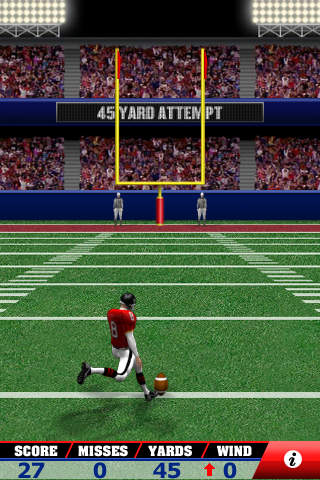|
GUEST EXPERT ARTICLE
Most young kickers can benefit from conserving motion, slowing things down, and making the kick smaller. These are the most common errors I find in working with high school players. Correcting them will create better body positions, timing and leverage, and result in improved accuracy, height and distance.
1.Be disciplined in your stance. If the kicker stands straight up in his stance, he has to tip forward to start momentum. This can result in being too low or flat-footed on the approach, causing the kicker to pull up excessively before they kick. This causes misses to the left.
Solutions:
- Keep 8-10" between your kicking toe and plant heel for stability.
- Keep your kicking foot heel flat on the ground. Your kicking leg should be in a straight line with your back.
- Lean your upper body forward. Keep your back straight, not arched or slouched.
- Raise your hands slightly to remind yourself to stay tall.
- Keep your shoulders level and still at all times through the approach and kick. They should be centered on the front of the ball (see "Center")
Most of the guys I've seen with this fault take too long of an approach to the ball. Shortening up (three natural walking steps and a foot on your walk back) makes your stance and approach a lot easier to manage.
2. Cross over on first full step ("Crossover step"). The biggest flaw I see with young players and soccer converts is that they change direction on their approach. They do this by stepping in "the hole" (behind the ball) and pushing off the instep of their kicking foot, creating a "crook". This does two things: 1) it kills their speed by breaking their momentum, and 2) it opens their hips up early and puts them on an outside (directly behind them) swing path. The outside swing kills foot speed by causing the kicker's knee to bend at an unnatural angle when they cock their leg. It also causes them to drop their hips and swing up.
Solution:
- Get some soccer corner cones. After your walk back, create a tight, straight lane to your plant location with the cones.
- Put a soft, flat object (towel, knee sleeve) in "the hole". Set it up so that it forces the outside of your foot into line with the other steps in your approach. Keep your thighs close together and execute the crossover step (no ball).
- Be light on the kicking foot when you set it down. The way to do this is to push hard off your plant foot after the jab step and cover more ground on this step. Always drive on your non-kicking foot. Also, land on the ball of your kicking foot with toes straight.
3. Center your sternum and hips to the ball. When you come out of your crossover step, it forces you to open your hips toward the ball. Through the drive (last) step, you should gradually turn your shoulders toward the ball (keep them level at all times). Reaching forward with your non-dominant arm helps with this. Centering to the ball puts your work directly in front of you: you can now pull (instead of pushing) with your kicking foot, and your foot path is now coming from the inside (in an arc from behind your other knee). You should also be swinging downhill, which enhances foot speed, before coming up through the ball
Solution:
- Put a cone at a 45 degree angle to the ball in front of it where you can use your peripheral vision and point your sternum and hips at it.
- Do this from a one-step approach first (turning your shoulders gradually through the whole sequence), then from a full approach (keep shoulders straight until starting the drive step).
- Walking down the field, when you're on your kicking foot step forward, raise your non-dominant arm, and turn your shoulders in like you're addressing the ball. Don't perform the kick; just step and turn, step and turn.
4. Establish body position - stay outside the ball. Many of the young kickers I see missing right miss there for a number of reasons. One of them is that they transfer their weight over the ball too early, and another is that they plant too wide. Sometimes, both are the case. I teach my kids to "plant tight and turn": they should plant within 11" of the ball, their lower bodies should be pitched, and their upper body should be straight up and down.
Solution:
- Do no-step kicks leaning against a wall or post. Put your hips and shoulders both against the post. Establish your centered position and swing from the knee down on an inside path, holding the rest of the body stable (keep your thigh stable as well).
- If you have a fabric weight belt, turn it backwards and tighten it around it on your chest. You can do this with one-step and full kicks, and it forces you to keep your upper body erect through the address and kick.
5. Execute a clean finish. If you aren't in control on your finish, you weren't in control when you struck the ball. I teach my kids to "lean and recover": get enough outside lean to strike the ball squarely, then use their trunk to transfer their weight and pull themselves back to center and square for the finish. While this is happening, the kicker should have his head turned back (not down) to look for the ball. After he lands his plant foot and then his kicking foot, his head can now come up and his right shoulder can come through last (the right arm should be at his side through the address and kick).
Solution:
- Lots of one-steps without the ball!
Learn more about Paul Perrone >>> |

 Alignment and Positioning Tips for Young Kickers
Alignment and Positioning Tips for Young Kickers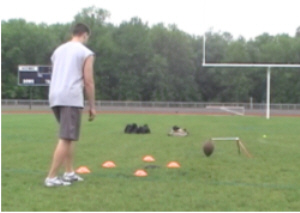
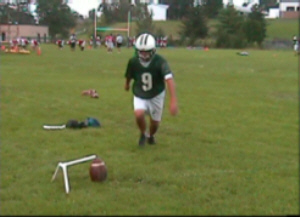
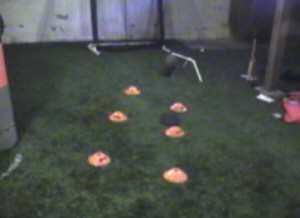
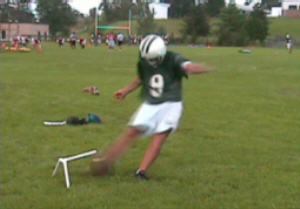
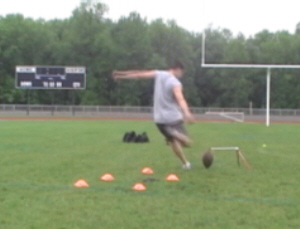
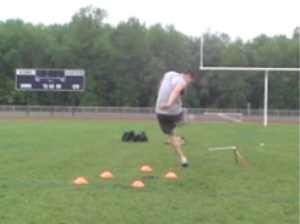
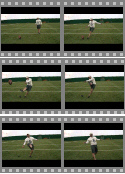
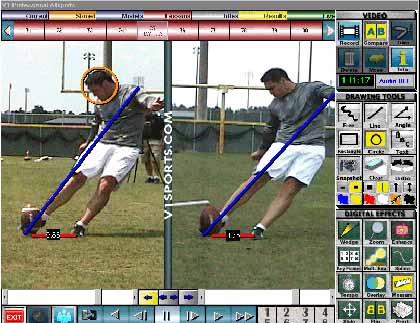
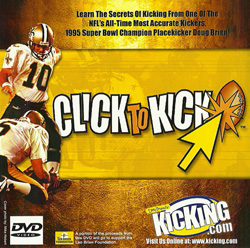
 Doug and Tommy's Frequently Asked Questions
Doug and Tommy's Frequently Asked Questions

